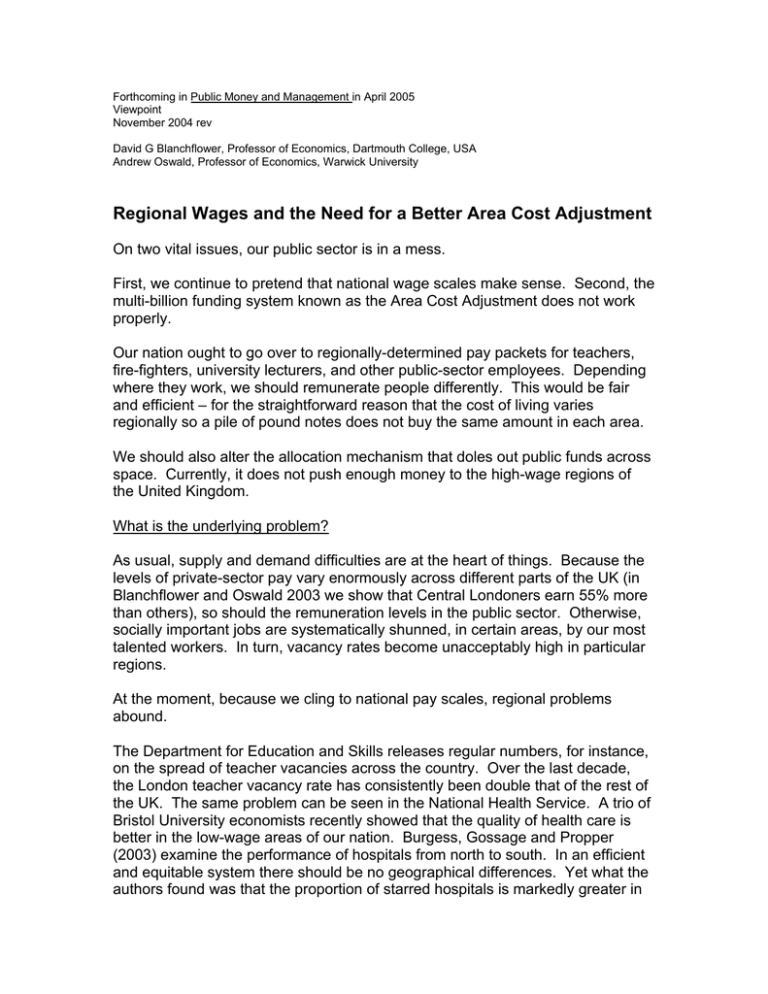Forthcoming in Public Money and Management in April 2005 Viewpoint
advertisement

Forthcoming in Public Money and Management in April 2005 Viewpoint November 2004 rev David G Blanchflower, Professor of Economics, Dartmouth College, USA Andrew Oswald, Professor of Economics, Warwick University Regional Wages and the Need for a Better Area Cost Adjustment On two vital issues, our public sector is in a mess. First, we continue to pretend that national wage scales make sense. Second, the multi-billion funding system known as the Area Cost Adjustment does not work properly. Our nation ought to go over to regionally-determined pay packets for teachers, fire-fighters, university lecturers, and other public-sector employees. Depending where they work, we should remunerate people differently. This would be fair and efficient – for the straightforward reason that the cost of living varies regionally so a pile of pound notes does not buy the same amount in each area. We should also alter the allocation mechanism that doles out public funds across space. Currently, it does not push enough money to the high-wage regions of the United Kingdom. What is the underlying problem? As usual, supply and demand difficulties are at the heart of things. Because the levels of private-sector pay vary enormously across different parts of the UK (in Blanchflower and Oswald 2003 we show that Central Londoners earn 55% more than others), so should the remuneration levels in the public sector. Otherwise, socially important jobs are systematically shunned, in certain areas, by our most talented workers. In turn, vacancy rates become unacceptably high in particular regions. At the moment, because we cling to national pay scales, regional problems abound. The Department for Education and Skills releases regular numbers, for instance, on the spread of teacher vacancies across the country. Over the last decade, the London teacher vacancy rate has consistently been double that of the rest of the UK. The same problem can be seen in the National Health Service. A trio of Bristol University economists recently showed that the quality of health care is better in the low-wage areas of our nation. Burgess, Gossage and Propper (2003) examine the performance of hospitals from north to south. In an efficient and equitable system there should be no geographical differences. Yet what the authors found was that the proportion of starred hospitals is markedly greater in the North than in the expensive South-East. The authors attribute this to the inability of southern hospitals to pay competitively. In short, public-sector wages should vary by region. The UK’s current ACA system There is a funding mechanism that is meant to recognise that it costs more to hire workers who are within commuting distance of Trafalgar Square. It is known as the Area Cost Adjustment. The system has just been redesigned. But it is still not right. Although often embedded in jargon, the idea of an Area Cost Adjustment is simple. It attempts to correct local authorities’ budgets for different costs of hiring in different areas. In other words it pays out more cash in expensive places. That is sensible. Yet it means that the precise way in which the ACA is designed is of crucial importance. Here we hit problems. Our newly implemented ACA system takes a data set known as the New Earnings Survey and uses equations to look at the patterns in private-sector pay by region. The statisticians try to calculate which are the UK’s high-wage places (like the centre of London) and which its low-paying ones (like Wales or Cornwall). To do this is not trivial. It is necessary for those who perform the calculations to bear in mind that different regions have different mixes of workers. A like-for-like calculation then has to be done: there is no point in comparing a judge’s salary slip in London with a farm-hand’s pay packet in Wales. What is needed is to compare a statistically representative person’s remuneration in each area of the country. But the wrong data set is still being used in the ACA We recently scrutinized the new Area Cost Adjustment system, in technical work reported in Blanchflower and Oswald 2003, and were not persuaded by what we found. First of all, the New Earnings Survey is not a good random sample of the population. Its coverage is unsatisfactory at the bottom end. Low-wage workers, who pay no tax, are under-represented. Unfortunately, this causes bias. It is particularly serious for London and the South-East. In that part of the UK, even the relatively low-paid often pay tax and thus get included in the New Earnings Survey (because cleaners and others earn a lot there, compared to cleaners in the cheaper areas of the country). Thus the low-paid show up in the New Earnings Survey in London but -- and this is the crucial point -- do not do so in, say, Wales or Cornwall. And this is what muddies things. It makes the average level of pay in a place like London appear lower than it really is - because the cleaners are included in the London sample but not elsewhere. Estimated pay differentials then get squeezed -- quite wrongly -- between north and south. As a consequence, the current ACA cash allocations give too much money to cheaper areas of the nation. Areas like Worcester also suffer unfairly, as we explain in our 2003 paper. Second, the New Earnings Survey does not record enough about people. Most worryingly, it has no information about workers’ education and qualifications. Hence it is not a good basis for doing like-for-like comparisons of employees across space in the UK. Apples get compared to oranges. How can this be put right? Use the right data The government ought to switch to a different data set. There is a natural one. It is the Labour Force Surveys. These provide accurate statistical pictures of workers in the United Kingdom. Exactly this point was made by an Independent Commission, last decade, headed by Professor Robert Elliott, which was set up by the government to settle these matters and decide how the Area Cost Adjustment should be done. The Elliott Inquiry (1996) was unequivocal. It said: “We recommend the use, as a data source, of the Labour Force survey.” p. 79. Yet, nearly ten years later, we are still waiting. Conclusion The UK needs regional pay in its public sector, and a better-designed Area Cost Adjustment. References Blanchflower, D.G. and Oswald, A. J. December 2003. “Calculating an Appropriate Regional Funding Adjustment for Worcestershire: A Report for Worcestershire County Council”. Worcestershire County Council. Burgess, S., Gossage, D. and Propper, C. September 2003. “Explaining Differences in Hospital Performance: Does the Answer Lie in the Labour Market?”, CMPO Working Paper 03/091, Bristol University, Department of Economics. Elliott, R.F., McDonald, D., and R. MacIver. July 1996. Review of the Area Cost Adjustment, Waverley Press, University of Aberdeen and the Department of Environment.




